
The discussion on the development direction and path is very important for every industry. In 2020, almost all public libraries have spent a special year in the fight against the COVID-19. Today, the impact of the epidemic continues and on the road of exploring the "Future", there are more challenges for the public libraries. Face to various uncertainties, what are librarians in the world thinking and doing? As the society is constantly upgrading and iterating, can public libraries catch up with the epoch development? What role should the public library play in the good life that people yearn for? With these questions in mind, we interviewed some iconic figures in the field of libraries in various countries to talk about their 2020 and views on the future of public libraries. We hope that our interviews will enable librarians from different countries to better understand each other and have a firmer belief that the future of public libraries will eventually be a bright and splendid world.
In this issue, we will launch an interview with Jackie Nytes, CEO of Indianapolis Public Library.
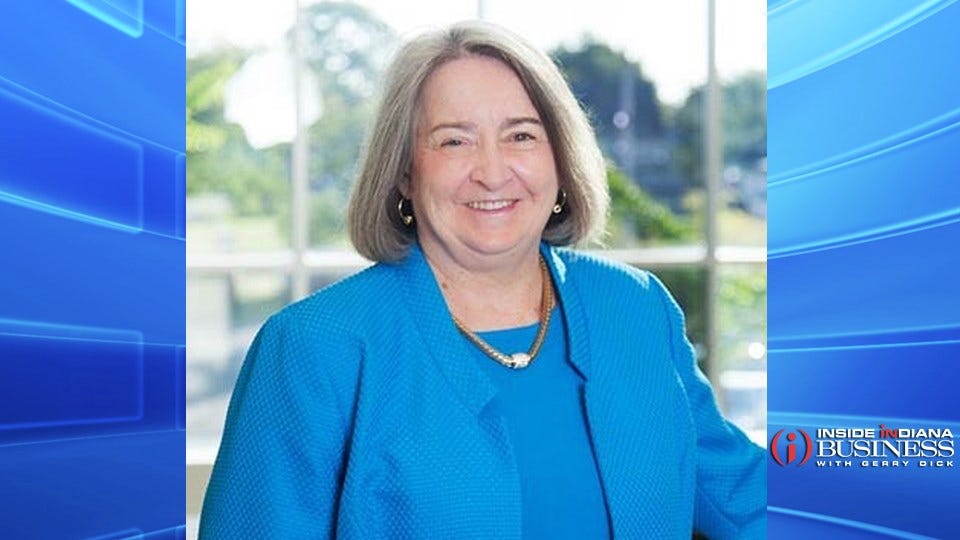
In January 2012, Jackie Nytes began her tenure as the 14th director in The Indianapolis Public Library’s illustrious history dating back to 1873. Prior to her current association with IndyPL, Nytes served as Associate Director of Management Services and then Chief Financial Officer from 1988 to 2001. In between those chapters, Nytes served 12 years as an elected member of the Indianapolis City-County Council, as well as a five-year term as Executive Director of the Mapleton-Fall Creek Development Corporation in Indianapolis. Nytes was Director of the Carmel-Clay Public Library in Carmel, Indiana from 1981-1988. She is a graduate of the University of Wisconsin where she received a BA in Political Science and Masters in Library Science. Her current civic engagement includes serving on the Boards of the Indianapolis Symphony Orchestra, the Immigrant Welcome Center, the Indianapolis Chamber of Commerce, and the Temple Bethel Restoration Committee. She is a recipient of the Sagamore of the Wabash and has served as an International Homestay family since 1987, hosting over 130 international students in her home. These relationships have resulted in a deep appreciation for the value of the immigrant experience and the richness of cultures beyond our shores as we seek to build a truly inclusive city!
The last year has been a journey no one could have predicted for our library and our city. We closed all of our libraries from March until June of 2020. During that time, the majority of our employees remained on payroll through a complicated plan to continue work remotely such as accounting and ordering new materials for the collection, or for those who had worked in the public areas--a rigorous schedule of remotely delivered staff training and on line patron service. During closure we provided premium pay for essential workers to come in during travel bans so that our facilities would be safely maintained.
Two dozen employees retired and that represented a loss of valuable experience and expertise at a time when all hiring from outside to fill vacancies was curtailed.
In order to reopen, we made major building modifications eliminating general seating and the number of computers available to increase social distancing, constructing plexi glass partitions to facilitate safe interactions between staff and patrons, and creating a system of door counters to limit attendance to proscribed safe numbers at each location.
Staff sewed 600 handmade masks for re-opening in the early days when Personal Protection Equipment (PPE) was hard to purchase. They produced shields on the 3D Printers and instituted new protocols for assisting patrons while maintaining social distancing!
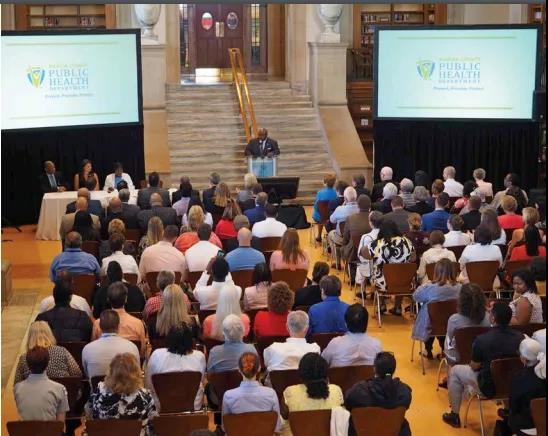
Now that Covid numbers are trending downward significantly, only a small number of nonpublic service staff are still working at home and many questions are being asked about whether that model might continue. Staff remains anxious about the virus, even though vaccines are now readily available for all employees. We have had no reports of any employees contracting the virus while at the workplace however so we are confident that our processes provided ample safety for our employees!
In addition to the physical plant changes, we pivoted from in person to all virtual programming for children and adults. This new approach resulted in 527 programs being presented virtually! We recorded 27,429 views of them by our patrons. This is one change that we believe will continue to have a place in our world even when we return to in- person library programming. We also offered “Curbside” service where patrons could request materials and have them delivered to their car with minimal interaction—this service has become very popular!
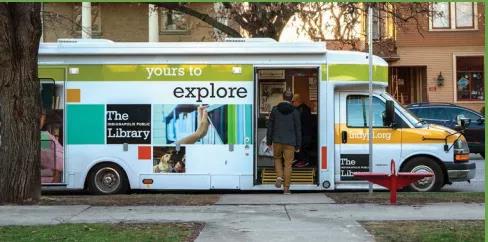
In total, we lost 34% of our open hours last year and as a result the demand for materials changed significantly. Interlibrary loans were down 74% and conventional physical circulation was down 20%. On the bright side, electronic content use was up 31% and we have indications that many of those new e resource users will stay in those formats. We have moved significant amounts of budget from print to e-materials as a result.
For the administration there were also adjustments. Our Human Resources team had to learn about and administer the many federal programs of benefits and job protections that were created in response to Covid. Our Finance team adjusted budgets repeatedly to fund the changes in the buildings and the acquisition of PPE for the staff, while chasing grant dollars to help pay for it all. And the Library Board learned to conduct all of its business over ZOOM calls while still providing ample transparency for the public.
Some American libraries have struggled depending on the source of their revenues. For example, income tax funded libraries such as those in the State of Ohio fared poorly as income tax collections dropped. However our funding is 80+ % property tax based. That is a less volatile taxing mechanism so we did not lose revenue on the public funding side. We did lose incremental monies that patrons spent at the library for printing and faxing, booking meeting rooms and paying parking. We concluded, given the pressures of the pandemic on low income families, that the time was right for the library to abandon the practice of charging late fees for materials returned past their due date. While this results in a loss of income to us, we feel that at this time in particular families need public institutions to understand their challenges and work to increase access to the Library not block it.
Our Foundation actually exceeded their charitable fund raising goals during the pandemic which is counter intuitive but a real blessing. We believe that many donors appreciated the heightened importance of the public library during a time when schools were closed and families were home bound and were quick to increase their support of our efforts.
The key lesson in all of this is to have a blended array of funding sources so that in a difficult time, you do not risk great losses by having too great a dependency on one type of funding resource. There is also renewed interest in consortiums to deliver services at lesser costs.
Digital communications and the move to digital formats for information are rapidly increasing and transforming the way our libraries function today. This trend impacts how we build our collections and how we reach out to our communities.
Looking to the library’s role in maintaining the record of society, we have the wonderful opportunity and the responsibility to track down, organize and digitize the written record much as we once built large archival collections of photographs, memoirs, minute books and marketing materials. This work is a great arena for collaboration among libraries as the technologies offer excellent means of sharing the end product. In the US, this is exemplified by the work of the Digital Public Library of America (DPLA) and here in Indiana by Indiana Memory @https://digital.library.in.gov/. The Indianapolis Public Library is heavily into this work having documented in digital format the history of a myriad of arts organizations and multiple government departments including our police and fire departments, parks department and public schools. You can see this growing collection at http://www.digitalindy.org/.

A new role for libraries that builds on this digital collection building is the actual act of publishing digital products. This year the Indianapolis Public Library is working with POLIS at the School of Informatics here at the University to create a new Digital Encyclopedia of Indianapolis which will launch in the summer of 2021. The Public Library holds the copyright to this new publication and will continue to add to it over time as the story of our city continues forward. Extensive citizen involvement in the planning of this new resource helps to insure that the story of our City is told in a factual and objective manner, utilizing a wide variety of techniques such as time lines and video linked to the text. It is a federated construction linking to numerous other digital resources across the city and producing a richer experience for the reader and researcher, one that can stay current with less effort and cost than a print encyclopedia could ever achieve.
And while we understand how to digitize the previously published record of mankind, our next challenge is understanding our role in working with the material that is born digital and seems at time to be either fleeting and ephemeral or at a minimum difficult to track down and retain given the trend now to publish scholarly work as well as many self-published titles only on the internet. The Indiana University Purdue University Library here in Indianapolis is delving deeply into this work and assisting both the faculty and the researchers in established standards for this work. We hope to learn from their leadership in this field.
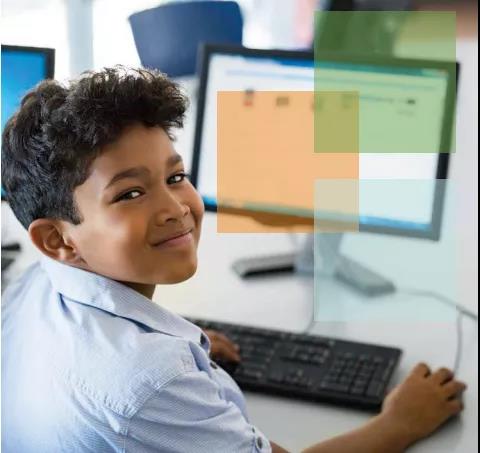
How we reach out to the public to communicate about the work of libraries and what we can offer is also becoming more digital today. No longer can we just print flyers and hope people will pick them up when they come in to visit the Library…some of our patrons will seldom come to visit us in person. Our messaging must reach out to people and customize what we communicate more than ever. We have launched a new product called Communico that allows us to customize messaging to sub groups of recipients based on choices they have selected, zip codes, or other aspects of market segmentation. WOWBRARY let’s patrons know of our new materials as soon as we order them. And social media grows in impact every day!
These are two big topics!
The main vendor that put the embargo one books for the first three months after release dropped the idea right before the pandemic really hit which was fortunate. Many publishers made special arrangements to access e books more affordably during the worst of the pandemic out of a sense of civic responsibility.
But today, pricing still remains high, and metered access expiring content is still an issue. However, some vendors are making things available for purchase AND metered access. This means we can purchase 1 or 2 copies to retain in perpetuity and then purchase the expiring content for the initial high demand. More content is becoming available as “cost per circ” as well, which also helps to serve that initial high demand. The shift of magazines from RBDigital to OverDrive was a big event this year, and has resulted in more discovery and usage of e magazines. We still have some content on Flipster as well. More vendors are trying to get into the market for e books--Vox books just announced “iVox” which are e books for the Tumblebooks early reader audience. SO many platforms can be confusing for patrons as the market develops. Overall, there has been no major news about changes in e book pricing models, as everyone has been focused on other issues.
Cyber security is a very real concern and a major focus for us now as it must be for all organizations who are increasingly working in the digital realms. Our efforts must begin with education for staff especially about the way that security is breached now days. This has become more and more threatening as phishing tricks and seemingly harmless emails can expose a library and its patrons to significant security exposures. Many libraries have purchased insurance to assist with the aftermath of such exposures, but the most important work is the work to avoid and ward off such exposures.
At our library we have installed stronger firewalls to protect our servers, and instituted policies and practices to help staff avoid situations when they might unwittingly expose us to cyber breaches.
We have just launched a new Strategic Plan for 2021-2023 and this continues to be our mission with one important change—we have added the phrase “for everyone” to the mission statement. This new plan can be found at www.indypl.org and in it you will see that we are committed to work with other organizations in the community who share the effort to support continued growth and learning. We are especially sensitive to the extent to which some groups have been marginalized and excluded from these opportunities, and we are being more intentional in focusing on areas that are of greatest need—Digital/Technology, Education, Reading and Writing, Health and Wellness, and Financial Literacy.
COIVD 19 has revealed to us the inequities that exist in access to information across society. Whether it be access to the internet itself or barriers in the languages that are offered for various resources, not everyone has the same opportunity and the Library must call attention to this and help address it. We have been circulating mobile hot spots in neighborhoods where we know access to the internet is especially low. In some communities we have been circulating Chrome books for families to borrow who have perhaps had internet access only on their phones and found that does not meet the need of their school age children.
Recent history in the United States has caused people to be more suspect than ever before about the validity of what they see on television and read on line or in print. Old methods of ensuring the credibility of information have been bypassed in this age of everyone having a platform from which to speak. As libraries, we must still seek to provide validation of the credibility of information that we offer and provide the community with tools to discern that credibility for themselves.
We are blessed here in Indy to have a very diverse population and the trends indicate that in the next twenty years, Indianapolis will have more population of color (Black and Brown people) than its historic Caucasian majority. Our diversity has diversified! And with it has come increased awareness of the traditional barriers we have had in place to authentic diversity.
Internally we have begun work to help our staff become aware of their biases and the unintended micro aggressions we display when interacting with folks who are in any way different from the majority population. We are asking all staff to read from selected lists of books that will help us gain a shared understanding of the history of racism in America, and we have instituted numerous internal processes to further share power across the wider employee group. We continue to strive for a more diverse staff so that our patrons can see themselves in the folks who serve them at the Library. And in all of our program planning we ask staff to consider the impact on and engagement with diverse communities in designing library activities.
Externally we continue to value our Sister Cities and look forward to the day when we can again plan activities together. Meanwhile we are doing more with local organizations to offer joint programming such as launching the Plaza Comunitaria with the Mexican Consulate to give Hispanic Hoosiers a chance to complete elementary and secondary educations in their first language. Our Central Library will now be the home of the Immigrant Welcome Center, a local not for profit that specializes in insuring that all immigrants can thrive in Indiana.
Honoring the history is important—our renovation allows us to show case the old building like a beautiful jewel that you display with a dark velvet cloth behind it to allow it to really show off! The Paul Cret (architect of the 1917 building) is our jewel in the front and the Evans Woolen Building (architect of the 6 story tower added in 2007) became the new backdrop that offers the key to future services. Both have proven to be very flexible…after the first ten years of operation of the joint facility, we rearranged many collections and services to reflect new needs and it has opened us up to additional opportunity—we created a Center for Black Literature and Culture in what was one of the original Cret reading rooms. It is stunning and integrates technology collections and exhibits along with a large book collection. The Tower has seen the expansion of the overall book collection, computer labs, and conventional children’s services in addition to the integration of more technology for children. And the views of the City from the top floor of the Tower make it a tourist “must see” stop!
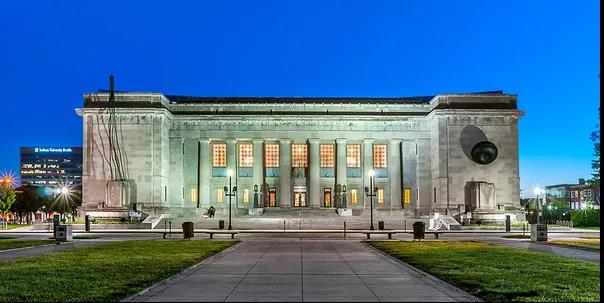
The ancient building of the library designed by Paul Cret in 1917

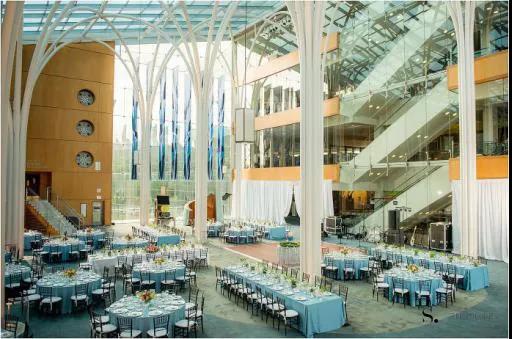
The new library building with six-story glass and steel frame structure built in 2007
The role of public librarians is changing rapidly today and will continue to for some time to come. Traditional reference service is less important as people have multiple sources for information and instruction –the web and YouTube for starters. But that very vastness also creates opportunity for librarians to offer guidance and advice in techniques of access and discerning what information is the most accurate and factual. As we face an increasing digital divide in our country between those with easy access to these new worlds of information, the Librarian is called upon more than ever to increase access and identify the skills and training that the public needs.
Multiple skill sets will continue to be required of librarians, it is not just about reading or reference, but it is also about technology, STEM activity, networking and linking resources calling out our staff’s abilities to stay current and aware of what is possible. Our work in guiding young readers will continue to play an important role as the skill and ultimately the joy of reading is something that needs cultivation like a young plant in a garden. That gift continues to be something that the Librarian will continue to be able to give our community.
We long for the day when we can again visit Haugzhou and hope to build on our earlier work together. We believe that once we have the health concerns behind us, and our respective countries are again able to focus on shared opportunities, the future for collaboration will be bright!